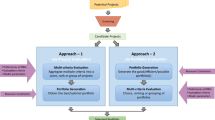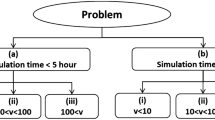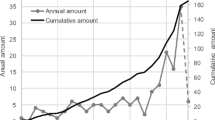Abstract
In general, it is difficult to select a satisfactory product concept because the information in the early stage of design process is subjective, qualitative, and even uncertain to design engineers. The correlations among engineering characteristics for a product concept also increase the complexity of conceptual design. Moreover, it becomes important to consider not only customer requirements but also product lifecycle requirements. In spite of these problems, the resources that can be allocated in the product development are limited so that a company should select the most satisfactory product concept within its available resources. Therefore, it is useful to develop a new method for efficiently supporting conceptual design under this complex design environment. To this end, this study proposes a decision support method with extended house of quality (HOQ). With the proposed method, the best product concept and the associated investment allocation can be decided concurrently under consideration of product lifecycle factors and resource constraints. As a mathematical model combined with the extended HOQ, a mixed integer nonlinear programming model is defined and three heuristic search algorithms are developed. To show the usefulness of the proposed algorithms, a case study and computational experiments are introduced.
Similar content being viewed by others
References
Jiao J (2006) Customer requirement management in product development: a review of research issues. Concurr Eng 14:173–185
Akao Y (2003) The leading edge in QFD: past, present, and future. Int J Qual Reliab Manage 20(1):20–35
Chan LK, Wu ML (2002) Quality function deployment: a literature review. Eur J Oper Res 143:463–497
Zhang Y, Wang HP, Zhang C (1999) Green QFD-II: a life cycle approach for environmentally conscious manufacturing by integrating LCA and LCC into QFD matrices. Int J Prod Res 37(5):1075–1091
Sullivan L (1986) Quality function deployment. Qual Prog 19(6):36–50
Martin MV, Kmenta S, Ishii K (1998) QFD and the designer: lessons from 200+ houses of quality. In: Proceedings of the World Innovation and Strategy Conference (WISE 98)
Wasserman GS (1993) On how to prioritize design requirements during the QFD planning process. IIE Trans 25(3):59–65
Park T, Kim KJ (1998) Determination of an optimal set of design requirements using house of quality. J Oper Manage 16(5):46–58
Bode J, Fung RYK (1998) Cost engineering with quality function deployment. Comput Ind Eng 35:587–590
Fung RYK, Tang J, Tu Y, Wang D (2002) Product design resources optimization using a non-linear fuzzy quality function deployment model. Int J Prod Res 40(3):585–599
Fung RYK, Tang J, Tu PY, Chen Y (2003) Modelling of quality function deployment planning with resource allocation. Res Eng Des 14:247–255
Reich Y, Levy E (2004) Managing product design quality under resource constraints. Int J Prod Res 42(13):2555–2572
Lai X, Xie M, Tan KC (2005) Dynamic programming for QFD optimization. Qual Reliab Eng Int 21:769–780
Yung KL, Ko SM, Kwan FY, Tam HK, Lam CW, Ng HP, Lau KS (2006) Application of function deployment model in decision making for new product development. Concurr Eng Res Appl 14(3):257–267
Störnebel K, Tammler U (1995) Quality function deployment als werzeug des umweltmanagement. In: UmweltWirtschafts Forum. pp 4–8
Cristofari M, Deshmukh A, Wang B (1996) Green quality function deployment. In: Proceedings of the 4th International Conference on Environmentally Conscious Design and Manufacturing. pp 297–304
Rahimi M, Weidner M (2002) Integrating design for environment (DfE) impact matrix into quality function deployment (QFD) process. J Sustain Prod Des 2:29–41
Kuo TC (2003) Green product development in quality function deployment by using fuzzy logic analysis. In: Proceedings of IEEE International Symposium on Electronics and the Environment. pp 88–93
Cagno E, Trucco P (2007) Integrated green & quality function deployment. International Journal of Product Lifecycle Management 2(1):64–82
Kobayashi H (2005) Strategic evolution of eco-products: a product life cycle planning methodology. Res Eng Des 16:1–16
Lei M, Yao L, Zhu Z (2007) The extended quality function deployment in product lifecycle design. Lect Notes Comput Sci 4402:401–408
Borg JC, Yan XT, Juster NP (2000) Exploring decisions' influence on life-cycle performance to aid ‘design for Multi-X’. Artif Intell Eng Des Anal Manuf 14:91–113
Yu S, Kato S, Kimura F (2001) EcoDesign for product variety: a multi-objective optimization framework. In: Proceedings of EcoDesign2001: 2nd International Symposium on Environmentally Conscious Design and Inverse Manufacturing, Tokyo. pp 293–298
Brezet H, van Hemel C (1997) Ecodesign: a promising approach to sustainable production and consumption. TU Delft, The Netherlands
Wimmer W, Züst R, Lee KM (2004) Ecodesign implementation: a systematic guidance on integrating environmental considerations into product development. Springer, Berlin
Wanyama W, Ertas A, Zhang HC, Ekwaro-osire S (2003) Life-cycle engineering: issues, tools and research. Int J Computer Integr Manuf 16(4–5):307–316
Umeda Y, Life Cycle Design Committee (LCDC) (2001) Toward a life cycle design guideline for inverse manufacturing. In: Proceedings of the Second International Symposium on Environmentally Conscious Design and Inverse Manufacturing (EcoDesign2001). pp 143–148
Stark J (2004) Product lifecycle management: paradigm for 21st century product realization. Springer, Berlin
Kiritsis D, Bufardi A, Xirouchakis P (2003) Research issues on product lifecycle management and information tracking using smart embedded systems. Adv Eng Inform 17(3–4):189–202
CIMdata (2002) Product lifecycle management—empowering the future of business. White paper, CIMdata Inc., Ann Arbor, Michigan, USA
Jun HB, Kiritsis D, Xirouchakis P (2007) Research issues in closed-loop PLM. Comput Ind 58(8–9):855–868
Alting L, Legarth JB (1995) Life cycle engineering and design. Ann CIRP 44(2):569–580
Jovane F, Alting L, Armillotta A, Eversheim W, Feldmann K, Seliger G, Roth N (1993) A key issue in product life cycle: disassembly. Ann CIRP 42(2):651–658
Kato S, Hata T, Kimura F (2001) Decision factors of product life cycle strategies. In: Proceedings of the supplement Ecodesign 2001: 2nd International symposium on environmentally conscious design and inverse manufacturing. pp 31–34
Kimura F, Suzuki H (1995) Product life cycle modeling for inverse manufacturing. In: Proceedings of the IFIP WG5.3 International conference on life-cycle modeling for innovative products and processes. pp 80–89
Takata S, Kimura F, van Houten FJAM, Westkämper E, Shpitalni M, Ceglarek D, Lee J (2004) Maintenance: changing role in life cycle management. Ann CIRP 53(2):643–655
Yoshimura M (1996) Design for X-Concurrent engineering imperatives. Design optimization for product life cycle. Chapman and Hall, London, pp 424–440
Erdos G, Kis T, Xirouchakis P (2001) Modeling and evaluating product end-of-life options. Int J Prod Res 39(6):1203–1220
Chan LK, Wu MK (2005) A systematic approach to quality function deployment with a full illustrative example. OMEGA Int J Manag Sci 33(2):119–139
Khoo LP, Ho NC (1996) Framework of a fuzzy quality function deployment system. Int J Prod Res 34(2):299–311
Liu ST (2005) Rating design requirements in fuzzy quality function deployment via a mathematical programming approach. Int J Prod Res 43(3):497–513
Bussieck MR, Pruessner A (2003) Mixed-integer nonlinear programming. Technical report. Available at: http://citeseer.ist.psu.edu/596677.html
Gray P, Hart W, Painton L, Philips C, Trahan M, Wagner J (1997) A survey of global optimization methods. Technical report, Sandia National Laboratories, Livermore, CA
Kreysziq E (2006) Advanced engineering mathematics, 9th edn. Wiley, New York
Mizuno S, Akao Y (1994) QFD: the customer-driven approach to quality planning and deployment. Asian Productivity Organization, Tokyo, Japan
Fung RYK, Law DST, Ip WH (1999) Design targets determination for inter-dependent product attribute in QFD using fuzzy inference. Integr Manuf Syst 10(6):376–384
Sobek DK II, Ward AC, Liker JK (1999) Toyota's principles of set-based concurrent engineering. Sloan Manage Rev 40(2):67–83
Author information
Authors and Affiliations
Corresponding author
Rights and permissions
About this article
Cite this article
Shin, JH., Jun, HB., Kiritsis, D. et al. A decision support method for product conceptual design considering product lifecycle factors and resource constraints. Int J Adv Manuf Technol 52, 865–886 (2011). https://doi.org/10.1007/s00170-010-2798-9
Received:
Accepted:
Published:
Issue Date:
DOI: https://doi.org/10.1007/s00170-010-2798-9




